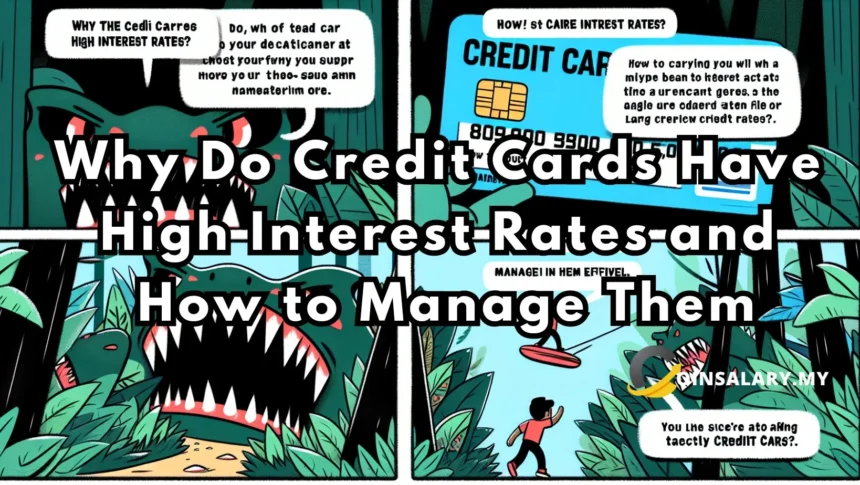Credit cards are convenient financial tools that can provide instant purchasing power and help build credit. However, they come with high-interest rates that can quickly add up if not managed carefully. Understanding why credit cards have such high-interest rates and learning strategies to handle them is crucial for avoiding debt traps and making the most of this financial tool. This article will dive into the reasons behind high credit card interest rates and offer practical tips on how to manage them effectively.
Why Credit Cards Have High Interest Rates
- Unsecured Debt
Unlike a mortgage or car loan, credit card debt is typically unsecured. This means there’s no collateral (like a house or car) backing the loan. Since lenders have no guarantee that they’ll recover their money if you default, they offset the risk with higher interest rates. - Higher Risk for Lenders
Credit card issuers face a higher risk of non-payment because cardholders have the flexibility to pay only a minimum amount each month. Unlike installment loans with fixed monthly payments, credit card companies have less control over how much you pay back each month, increasing their risk and the likelihood of default. - Credit Score and Individual Risk
Credit card interest rates vary based on individual credit scores. For cardholders with lower credit scores or limited credit histories, issuers often impose higher interest rates to account for the potential risk of non-payment. In contrast, customers with high credit scores may receive lower rates as they’re perceived as lower-risk borrowers. - Short-Term Loans
Credit cards are designed for short-term borrowing. Unlike personal loans or mortgages, which are repaid over years, credit card balances can fluctuate monthly. The interest rates are higher to encourage prompt repayment and discourage long-term debt accumulation. - Incentives and Rewards Programs
Many credit cards offer incentives, such as cash back, travel points, and rewards programs. To cover the cost of these perks, issuers often set higher interest rates. These perks add value for customers but come at a price if balances aren’t paid off each month. - Operational Costs and Fraud Risks
Issuing credit cards comes with operational costs, including customer service, fraud prevention, and transaction processing. Credit card fraud is also a major concern, and fraud-related losses can add up. Higher interest rates help card issuers recover some of these costs.
How to Manage High Credit Card Interest Rates
- Pay Off the Balance Monthly
The best way to avoid high-interest charges is to pay off your balance in full every month. By doing so, you can enjoy the benefits of using a credit card without incurring interest. Many credit cards offer a grace period, which allows you to avoid interest if the balance is paid before the due date. - Make More Than the Minimum Payment
If paying the full balance isn’t possible, aim to pay more than the minimum payment each month. Minimum payments typically cover only a small portion of the principal balance, meaning most of your payment goes toward interest. Paying extra reduces the principal faster and lowers the total interest paid over time. - Look for Balance Transfer Options
Many credit cards offer introductory 0% APR balance transfer promotions for new cardholders. If you have high-interest credit card debt, consider transferring your balance to a card with a lower interest rate or 0% APR. This allows you to pay down your debt interest-free during the promotional period, typically lasting 12-18 months. - Negotiate a Lower Interest Rate
Contact your credit card issuer to discuss the possibility of lowering your interest rate. Cardholders with good payment histories and strong credit scores may be eligible for lower rates, even if it’s a temporary reduction. This can save money on interest charges over time. - Use a Debt Repayment Strategy
Debt repayment methods, such as the snowball and avalanche methods, can help you pay down balances faster. The snowball method focuses on paying off the smallest balance first, which can be motivating, while the avalanche method prioritizes debts with the highest interest rates first, minimizing interest costs. - Consider a Personal Loan
If you’re struggling to pay down high-interest credit card debt, consider consolidating your debt with a personal loan that has a lower interest rate. This approach allows you to make fixed monthly payments over a specified term, often saving money on interest compared to revolving credit card debt. - Track Spending and Budget Accordingly
Monitoring your spending and creating a budget can prevent credit card debt from spiraling out of control. By knowing where your money goes, you can identify areas to cut back, freeing up funds to pay down your credit card balance more effectively. - Avoid Cash Advances
Cash advances typically come with higher interest rates and fees compared to regular purchases. They also begin accruing interest immediately, without a grace period. To minimize costs, avoid using your credit card for cash advances whenever possible. - Take Advantage of Credit Card Rewards Responsibly
Many credit cards offer rewards, but these perks should be approached carefully. Only spend within your means, and avoid overspending for the sake of earning rewards. When managed well, rewards can add value, but if you carry a balance, the interest can outweigh the benefits.
Pros and Cons of Credit Cards with High Interest
Pros:
- Convenience for purchasing and emergency expenses
- Potential for building credit if managed well
- Rewards and cashback benefits for regular users
Cons:
- High-interest charges on carried balances
- Potential for debt accumulation and financial strain
- Risk of affecting credit score due to high balances or missed payments
Conclusion
Credit cards can be valuable financial tools if used responsibly. Understanding why they have high-interest rates highlights the importance of using them wisely to avoid excessive costs. By paying off balances promptly, seeking lower rates, and maintaining disciplined spending habits, you can manage your credit card debt and make the most of the benefits they offer. Remember, the key to maximizing the advantages of a credit card while minimizing costs is to avoid carrying a high balance whenever possible.




